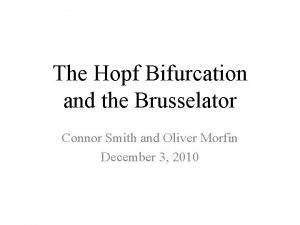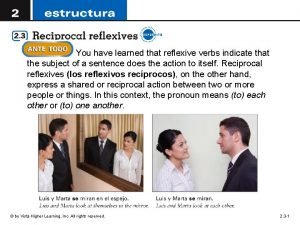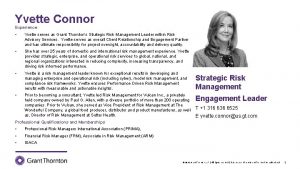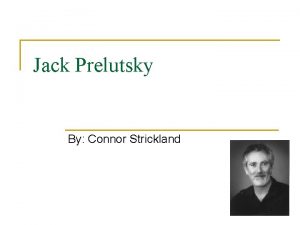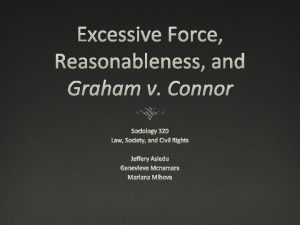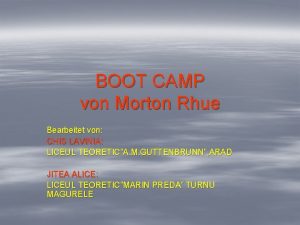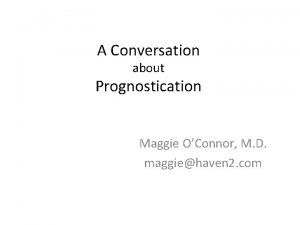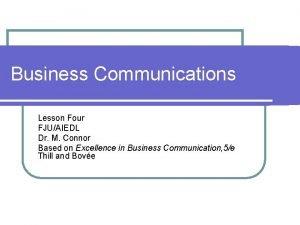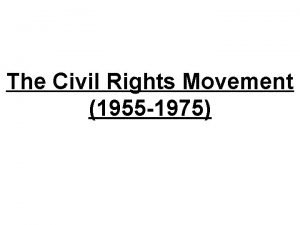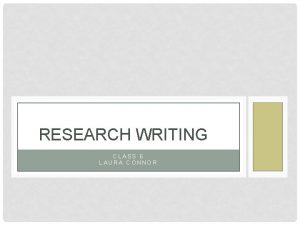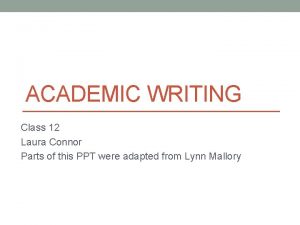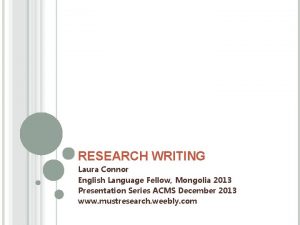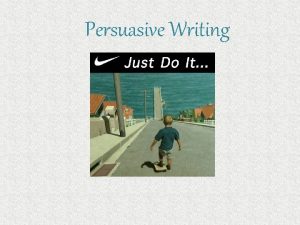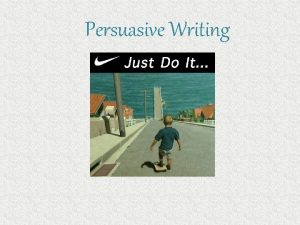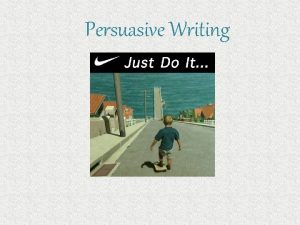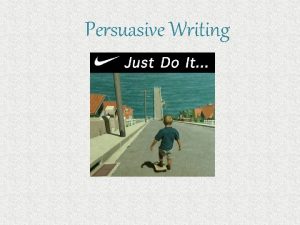Laura Connor RESEARCH WRITING CLASS 9 Laura Connor























- Slides: 23

Laura Connor RESEARCH WRITING CLASS 9

Laura Connor, English Language Fellow 2013 TODAY’S OBJECTIVES � SWBAT read to understand the methods section of a research paper. � SWBAT determine count noun vs. noncount nouns � SWBAT use sequence & transition words to properly communicate their methods of research

WARM UP: REVIEWING CONJUNCTIONS Create a sentence using the words below: Over the years/because � Example: Over the years, technology has become more important because people all over the world rely on it. 1. Initially/ however 2. In conclusion / therefore

YESTERDAY’S AGENDA: Read AIT’s sections on Method: � Method & Research Design � Verb Tense & Method � Voice in the Method Chapter (Active vs. Passive Voice) q Read Hanyang’s English Solutions Chapter 7: Methods This chapter will give you a better understanding of language and grammar used in the method’s section of research

GRAMMAR MINI LESSON USING THE ARTICLES: the/ a/ an � The most important first step in choosing the correct article is to categorize the noun as a count noun or non-count noun � - A count noun is a noun that can have a number in front of it: � Example: people. 1 teacher, 3 books, 76 cups, 1, 000 � - An uncount noun is a noun that cannot have a number put in front of it: � Example: 1 water, 10 airs, 21 oils, 39 informations

COUNT NOUNS • You can put a number in front of a count noun. (You can make a count noun plural. ) • You can put both a/an and the in front of a count noun. • You must put an article** in front of a singular count noun. • You use a plural count noun with no article if you mean all or any of that thing. • You use the with count nouns: • the second and subsequent times you use the noun in a piece of speech or writing • when the listener knows what you are referring to (maybe because there is only one of that thing) • You use an (not a) when the next word (adverb, adjective, noun) starts with a vowel sound. I have 3 books in my bag OR I have books in my bag. Can you pass me a book? Can you pass me the book? I am reading Harry Potter. The book is very good. NOT: Can you pass me book?

NON-COUNT NOUNS • You cannot put a number in front of an non-count noun. • You cannot say a/an with an uncount noun. • You cannot make an uncount noun plural • You use an uncount noun with no article if you mean that thing in general. • You use the with an uncount noun when you are talking about a particular example of that thing. Uncount nouns are often preceded by phrases such as: a lot of. . (luck), a piece of. . (chocolate), a bottle of. . (milk), a grain of. . (rice). * Instead of an article, the noun can also be preceded by a determiner such as this, that, some, many or my, his, our, etc.

YOUR TURN: ARTICLE USE PRACTICE � http: //esl. fis. edu/grammar/multi/article 2. htm � More practice with “the” and non-count nouns http: //esl. fis. edu/grammar/multi/article 1. htm

METHOD’S SECTION: AIT BOOK OVERVIEW OF HOW YOUR RESEARCH IS ORGANIZED: • Introduction: Introduction of research problem introduction of objectives introduction of how objectives will be achieved (methodology), optional introduction of main findings and conclusions, optional • Literature review: Review of previous work relating to research problem (to define, explain, justify) review of previous work relating to methodology (to define, explain, justify) review of previous work relating to results (particularly reliability, etc. ) • Method: How the results were achieved): explanation of how data was collected/generated · explanation of how data was analyzed explanation of methodological problems and their solutions or effects • Results and Discussion: Presentation of results interpretation of results discussion of results (e. g. comparison with results in previous research, effects of methods used on the data obtained) • Conclusions: Has the research problem been “solved”? to what extent have the objectives been achieved? what has been learnt from the results? how can this knowledge be used? what are the shortcomings of the research, or the research methodology? etc.



PASSIVE VOICE VERBS � You can recognize passive voice because the verb phrase will include a form of be (was, am, are, been, is). Don't assume that just because there is a form of 'be' that the sentence is passive. � � Example: The research was conducted over a period of 10 weeks. Sometimes a prepositional phrase like "by the" in the sentences above indicates that the action is performed on the subject, and that the sentence is passive. � Example: The experiment was conducted by the researcher.

EXAMPLE The infill material considered was mainly concrete: several concrete qualities were studied in order to investigate the influence of variation of the elastic modulus of the infill; moreover the C 20 lightweight concrete (LWC) and polyurethane (PUR) were considered as alternatives. As these two materials, especially PUR, offer the advantage of low weight we thought it worthy to include them in our analysis.

LETS READ THIS METHODS SECTION TOGETHER



EXPLAIN THE PURPOSE OF YOUR METHODS It is good writing to explain the purpose of your methods or procedures especially if the methods are not standard. The structures [To +Verb] or [In order to +Verb] enable the author to explain why methods were used. EXAMPLE STRUCTURES • In order to determine … • To estimate/ To measure/ To calculate/ • To verify/ To evaluate/ To define/ • To obtain/ To model • To ensure the reliability of/ To check the validity of

YOUR TURN! What was / is / will be the purpose of your methods of research? For example:

USING SEQUENCE WORDS � Sequence words are important to use during this section of your writing so that others may easily follow the steps of your methods of research. � Examples: � first, then, also, after, next, finally, while, as soon as, consecutively, simultaneously, and sequentially.

WHAT METHODS ARE IN YOUR RESEARCH? � Your turn! � Write the sequence of methods that you took to collect data, or WILL use to collect data. � Be aware of verb tense � First, � Second, � While, � Consequently,

TRANSITION WORDS ARE IMPORTANT TOO…

YOUR TURN! Add in an additional information that the reader may need to know about your methods, and/or how data was collected. Example:

HOMEWORK � Email me your introduction, literature review, and literature review outline of sources that you have been using � Finish reading AIT’s section on Methods & Hanyang’s Chapter 7 � http: //esl. fis. edu/grammar/single/passive_r. ht m
 Stefan kährs
Stefan kährs Hopf bifurcation
Hopf bifurcation Laura veia a elian todos los dias
Laura veia a elian todos los dias Yvette connor
Yvette connor Dani connor
Dani connor Supply chain cisco
Supply chain cisco Connor strickland fire
Connor strickland fire Graham vs connor
Graham vs connor Graham v connor
Graham v connor Boot camp connor steckbrief
Boot camp connor steckbrief Annie o'connor physical therapist
Annie o'connor physical therapist Maggie oconnor
Maggie oconnor As connor scanned the employment opportunities
As connor scanned the employment opportunities Ewan o'connor
Ewan o'connor Veronica e connor middle school
Veronica e connor middle school Kişilik envanteri testi
Kişilik envanteri testi Indent messages connor
Indent messages connor Archbishop denis o'connor catholic high school
Archbishop denis o'connor catholic high school What commandment is thou shalt not steal
What commandment is thou shalt not steal Eugene “bull” connor
Eugene “bull” connor Plant adaptations temperate deciduous forest
Plant adaptations temperate deciduous forest Connor pratt
Connor pratt Chris o'connor md
Chris o'connor md Fat connor
Fat connor

